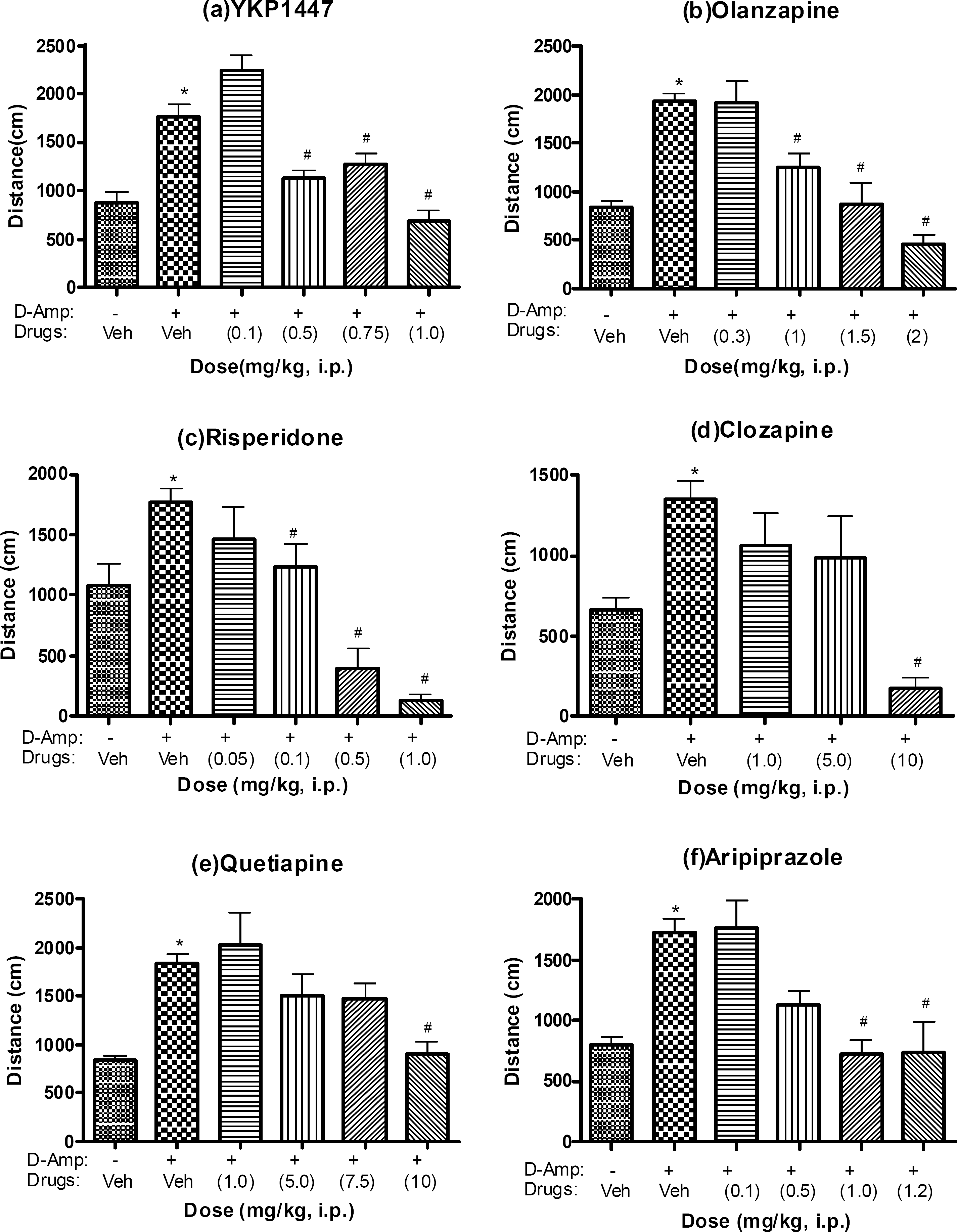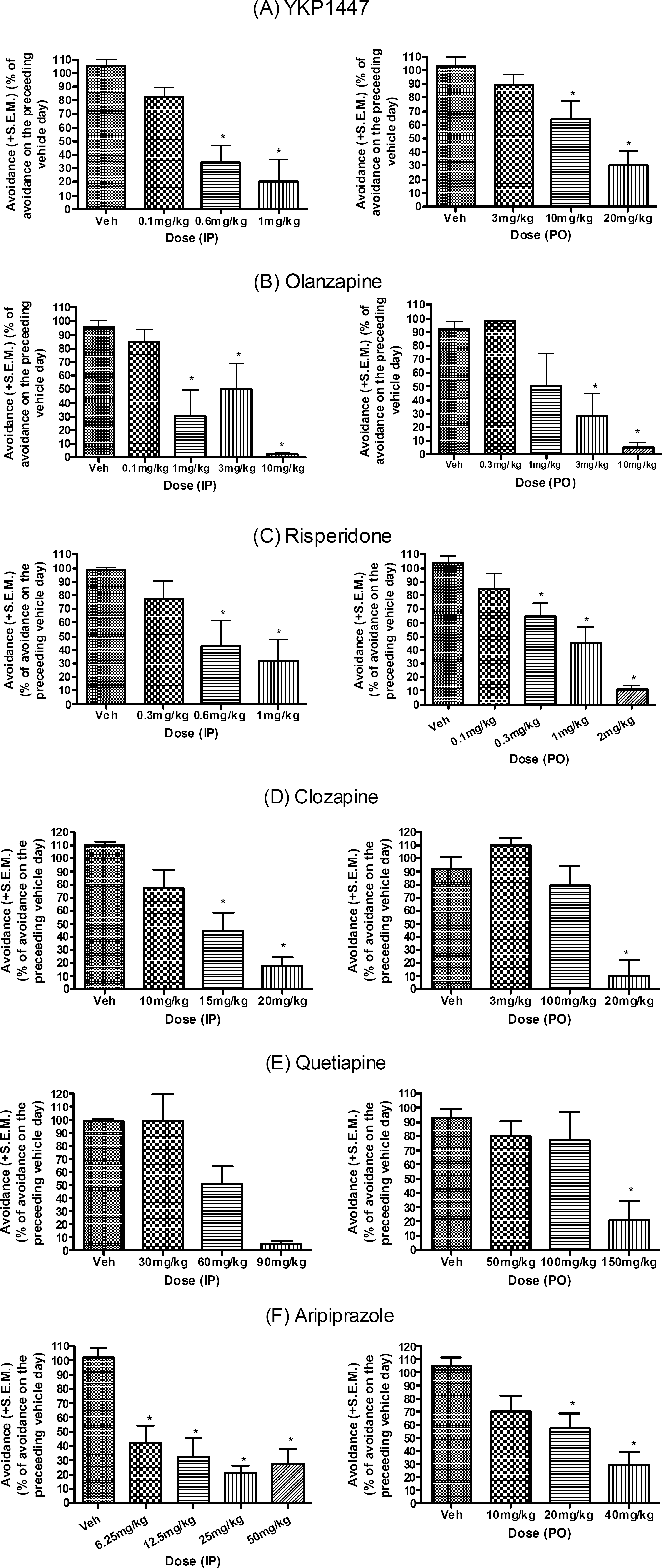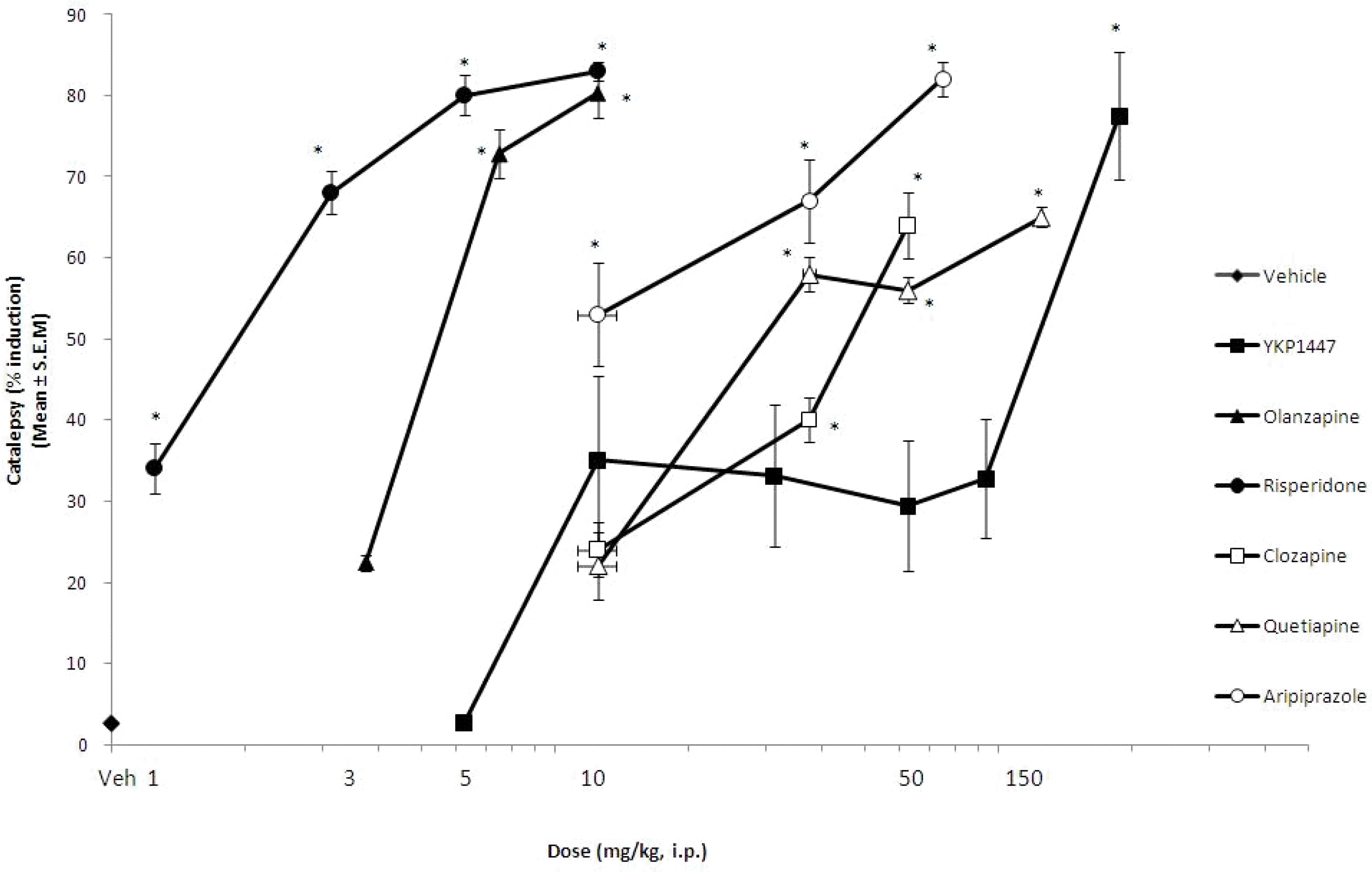Abstract
(S)-Carbamic acid 2-[4-(4-fluoro-benzoyl)-piperidin-1-yl]-1-phenyl-ethyl ester hydrochloride (YKP1447) is a novel “atypical” antipsychotic drug which selectively binds to serotonin (5-HT2A, Ki=0.61 nM, 5-HT2C, Ki=20.7 nM) and dopamine (D2, Ki=45.9 nM, D3, Ki=42.1 nM) receptors with over 10~100-fold selectivity over the various receptors which exist in the brain. In the behavioral studies using mice, YKP1447 antagonized the apomorphine-induced cage climbing (ED50=0.93 mg/kg) and DOI-induced head twitch (ED50=0.18 mg/kg) behavior. In the dextroamphetamine-induced hyperactivity and conditioned avoidance response (CAR) paradigm in rats, YKP1447 inhibited the hyperactivity induced by amphetamine (ED50=0.54 mg/kg) and the avoidance response (ED50=0.48 mg/kg); however, unlike other antipsychotic drugs, catalepsy was observed only at much higher dose (ED50=68.6 mg/kg). Based on the CAR and catalepsy results, the therapeutic index (TI) value for YKP1447 is over 100 (i.p.). These results indicate that YKP1447 has an atypical profile and less undesirable side effects than currently available drugs.
REFERENCES
Arnt J. Pharmacological specificity of conditioned avoidance response inhibition in rats. Inhibition by neuroleptics and correlation to dopamine receptor blockade. Acta Pharmacol Toxicol. 51:321–329. 1982.

Bartoszyk GD., Böttcher H., Seyfried CA. EMD 281014, a new selective serotonin 5-HT2A receptor antagonist. Eur J Pharmacol. 473:229–230. 2003.

Carlsson A., Lindqvist M. Effect of chlorpromazine or haloperidol on the formation of 3-methoxytyramine and normetanephrine in mouse brain. Acta Pharmacol (Kbh.). 20:140–144. 1963.
Cook L., Morris RW., Mattis PA. Neuropharmacological and behavioral effects of chlorpromazine (thorazine hydrochloride). J Pharmacol Exp Ther. 113:11–12. 1955.
Costentin J., Protais P., Schwartz JC. Rapid and dissociated changes in sensitivities of different dopamine receptors in mouse brain. Nature. 257:405–407. 1975.

Darmani NA., Martin BR., Pandey U., Glennon RA. Do functional relationships exist between 5-HT1A and 5-HT2 receptors? Pharmacol Biochem Behav. 36:901–906. 1990.

Davidson AB., Weidley E. Differential effects of neuroleptic and other psychotropic agents on acquisition of avoidance in rats. Life Sci. 18:1279–1284. 1976.

Dunham NW., Miya TS. A note on a simple apparatus for detecting neurological deficit in rats and mice. J Am Pharm Assoc. 46:208–209. 1957.
Egashira N., Mishima K., Uchida T., Hasebe N., Nagai H., Mizuki A., Iwasaki K., Ishii H., Nishimura RJ., Shoyama Y., Fujiwara M. Anandamide inhibits the DOI-induced head-twitch response in mice. Psychopharmacology. 171:382–389. 2004.

Gustafsson B., Christensson E. Amperozide, a new putative antipsychotic drug with a limbic mode of action on dopamine mediated behavior. Pharmacol Toxicol. 66(Suppl 1):12–17. 1990.
Kroeze WK., Hufeisen SJ., Popadak BA., Renock SM., Steinberg S., Ernsberger P., Jayathilake K., Meltzer HY., Roth BL. H1-histamine receptor affinity predicts short-term weight gain for typical and atypical antipsychotic drugs. Neuropsychopharmacology. 28:519–526. 2003.

Janssen PAJ., Niemegeers CJE., Smellekens KHL. Is it possible to predict the clinical effects of neuroleptic drugs (major tranquilizers) from animal data? Drug Res. 15:56–69. 1965.
Jones BJ., Blackburn TP. The medical benefit of 5-HT research. Pharmacol Biochem Behav. 71:555–568. 2002.

Matthysse S. Antipsychotic drug actions: a clue to the pathology of schizophrenia? Fed Proc. 32:200–205. 1973.
Meltzer HY., Li Z., Kaneda Y., Ichikawa J. Serotonin receptors: their key role in drugs to treat schizophrenia. Progr Neuro Psychopharmacol Biol Psychiatr. 27:1159–1172. 2003.
Moore NA., Tye NC., Axton MS., Risius FC. The behavioral pharmacology of olanzapine, a novel “atypical” antipsychotic agent. J Pharmacol Exp Ther. 262:545–551. 1992.
Moore S., Kenyon P. Atypical antipsychotics, clozapine and sulpiride do not antagonize amphetamine-induced stereotyped locomotion. Psychopharmacology. 114:123–130. 1994.
Ogren SO., Hall H., Kohler C., Magnusson O., Lindbom LO., Angeby K., Florvall L. Remoxipride, a new potential antipsychotic compound with selective antidopaminergic actions in the rat brain. Eur J Pharmacol. 102:459–474. 1984.
Park WK., Jeong DY., Yun CW., Lee SH., Cho HY., Kim GD., Koh HY., Pae AN., Cho YS., Choi KI., Jung JY., Jung SH., Kong JY. Pharmacological actions of a novel and selective dopamine D3 receptor antagonist, KCH-1110. Pharm Research. 48:615–622. 2003.

Peroutka SJ., Snyder SH. Relationship of neuroleptic drug effects at brain dopamine, serotonin, a-adrenergic, and histamine receptors to clinical potency. Am J Psychiatry. 137:1518–1522. 1980.
Protais P., Constentin J., Schwartz JC. Climbing behavior induced by apomorphine in mice: a simple test for the study of dopamine receptors in striatum. Psychopharmacology. 50:1–6. 1976.

Protais P., Costentin J., Schwartz JC. Climbing behavior induced by apomorphine in mice: a simple test for the study of dopamine receptors in striatum. Psychopharmacology (Berlin). 50:1–6. 1976.

Reavill C., Kettle A., Holland V., Riley G., Blackburn TP. Attenuation of haloperidol-induced catalepsy by a 5-HT2C receptor antagonist. Br J Pharmacol. 126:572–574. 1999.

Schreiber R., Brocco M., Audinot V., Gobert A., Veiga S., Millan MJ. (1-(2,5-dimethoxy-4-iodophenyl)-2-aminopropane)-induced head-twitches in the rat are mediated by 5-hydroxytryptamine (5-HT) 2A receptors: modulation by novel 5-HT2A/2C antagonists, D1 antagonists and 5-HT1A agonists. J Pharmacol Exp Ther. 273:101–112. 1995.
Sibley DR., Monsma Jr FJ., Shen Y. Molecular neurobiology of dopaminergic receptors. Int Rev Neurobiol. 35:391–415. 1993.

Snyder SH., Banergee SP., Yamamura HI., Greenberg D. Drugs, neurotransmitters and schizophrenia. Science. 184:1243–1245. 1974.

Sokoloff P., Giros B., Martres MP., Bouthenet ML., Schwartz JC. Molecular cloning and characterization of a novel dopamine receptor D3 as a target for neuroleptics. Nature. 347:146–151. 1990.

Sokoloff P., Schwartz JC. Novel dopamine receptors half a decade later. Trends Pharmacol Sci. 16:270–275. 1995.

Stahl SM. Psychopharmacology of antidepressants. 1st ed.Martin Dunitz Ltd;London: p. p. 31–38. 1997.
Van Rossum JM. The significance of dopamine-receptor blockade for the action of neuroleptic drugs. Arch Int Pharmacodyn Ther. 160:492–494. 1966.
Wadenberg ML., Hicks PB. The conditioned avoidance response test re-evaluated: is it a sensitive test for the detection of potentially atypical antipsychotics? Neurosci Biohav Rev. 23:851–862. 1999.

Wadenberg ML., Kapur S., Soliman A., Jones C. Dopamine D2 receptor occupancy predicts catalepsy and the suppression of conditioned avoidance response behavior in rats. Psychopharmacology. 150:422–429. 2000.
Willins DL., Meltzer HY. Direct injection of 5-HT2A receptor agonists into the medial prefrontal cortex produces a head-twitch response in rats. J Pharmacol Exp Ther. 282:699–706. 1997.
Yoon BS., Park EH., Park EH., Kwon JT., Hong SB., Dong SM., Kim YH., Heo J., Ji MK., Kim YG., Kwak BS., Choi JS., Kim HT. Effects of a new antipsychotic drug (YKP1447) on impaired prepulse inhibition induced by apomorphine and phencyclidine in rats. Korean J Psychopharmacol. 19:38–45. 2008.
Fig. 1.
Effects of YKP1447, olanzapine, risperidone, clozapine, quetiapine and aripiprazole on dextroamphetamine-induced hyperactivity in rats. The locomotor activity of dextroamphetamine was measured every 10 min for 1 h immediately after injection of amphetamine (1.5 mg/kg, i.p.). YKP1447 (a, top left panel), olnazapine (b, top right panel), risperidone (c, middle left), clozapine (d, middle right), quetiapine (e, bottom left) and aripiprazole (f, bottom right) or vehicle (Veh), administered (i.p.) 30 min before the injection of dextroamphetamine. The locomotor activities for 1 h are expressed as the total counts. Each value is mean±S.E.M. of seven to eight rats. ∗p<0.01, compared with vehicle-vehicle group (t-test), #p<0.05, when compared with amphetamine control group (the post-hoc test was Dunnett's multiple comparisons test).

Fig. 2.
Dose-response of YKP1447 (A), olanzapine (B), risperidone (C), clozapine (D), quetiapine (E) and aripiprazole (F) on CAR paradigm in rats. All drugs were administered i.p. (left panels) 30 min or p.o. (right panels) 60 min prior to test. Values are mean±S.E.M. (n=6~10) percentage avoidances compared to the preceding vehicle-day (e.g. pre-test), with each animal serving as their own control. Statistical analyses were performed by a one-way ANOVA with post hoc Dunnett's test. ∗p<0.05.

Fig. 3.
Effect of YKP1447, olanzapine, risperidone, clozapine, quetiapine and aripiprazole on induction of catalepsy in rats. Data are expressed as mean±S.E.M. ∗p<0.05 vs. vehicle (Veh)-treated group (the post hoc test was Dunnett's).

Table 1.
Effects of YKP1447, olanzapine, risperidone, clozapine, quetiapine and aripiprazole on apomorphine-induced climbing in mice
| ED50 (95% C.l.)∗ | ||
|---|---|---|
| mg/kg, ip | mg/kg, po | |
| YKP1447 | 0.93 (0.56~1.55) | 4.3 (4.0~4.7) |
| Olanzapine | 0.28 (0.11~0.72) | 1.2 (0.6~2.4) |
| Risperidone | 0.052 (0.03~0.1) | 0.052 (0.026~0.1) |
| Clozapine | 5.14 (4.36~6.06) | 6.74 (5.04~9.01) |
| Quetiapine | 3.9 (2.4~6.5) | 21.8 (20.1~23.5) |
| Aripiprazole | 0.3 (0.12~0.75) | 1.0 (0.93~1.07) |
Table 2.
Effects of YKP1447, olanzapine, risperidone, clozapine, quetiapine and aripiprazole on DOI-induced head twitch behavior in mice
| Treatment | ED50 (95% C.l.)∗ |
|---|---|
| mg/kg, ip | |
| YKP1447 | 0.18 (0.10~0.32) |
| Olanzapine | 0.024 (0.007~0.087) |
| Risperidone | 0.0054 |
| Clozapine | 0.56 (0.48~0.66) |
| Quetiapine | 2.45 (1.97~3.05) |
| Aripiprazole | 1.29 (1.02~1.64) |
Table 3.
Binding affinity (Ki to nM or % inhibition at 100 nM except M1 which is % inhibition at 1 μM) of YKP1447 for the various receptors. YKP1447 showed highly selective binding affinities to the 5-HT2A, 2C, D2 and 3 receptor subtypes
| 5HT1A | 5HT2A | 5HT2C | 5-HT3 | 5-HT4 | 5HT5A | 5HT6 | D1 | D2L | D2S | D3 | D4.2 | D4.4 | D5 | H1 | M1 | α1 | |
|---|---|---|---|---|---|---|---|---|---|---|---|---|---|---|---|---|---|
| YKP1447 | 2% | 0.61 | 20.7 | −15% | 9% | 1% | 9% | 4% | 45.9 | 44.5 | 42.1 | 6% | 12% | −5% | 2100 | 3% | 3,750 |




 PDF
PDF ePub
ePub Citation
Citation Print
Print


 XML Download
XML Download